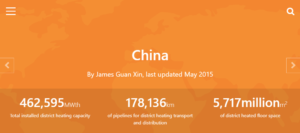
China is substantially growing its district heating market, with total sales increasing by 21% between 2009 and 2013. The total installed district heating capacity is 462,595 MWth, with approximately 98% of the total area covered by district heating is located in north China. Furthermore, it is estimated that nearly 55% of the total heating surface in north China is supplied by district heating.
In 2013 China’s carbon emissions reached 10 billion tonnes, which accounted for 28% of total global emissions and exceeded the combined amount of the EU and United States. The low efficiency of individual heating systems and the low number of energy-saving buildings greatly contribute to carbon emissions. Therefore, increasing the share of district heating in northern China, above the current level of 55%, will support environmental ambitions.
District cooling demand has increased rapidly followed the urbanisation curve and it is estimated that 27% of total electricity generation in 2013 was consumer for cooling public and commercial buildings. Due to the special conditions and design in order to achieve high efficiency and low cost, district cooling systems are still under debate in China. At present, the main technologies utilised for cooling are large-scale centralised electric compression chillers and individual electric compression chillers.
Combined heat and power (CHP) accounts for 20% of the total electricity production in China and, from 2008 to 2012, the installed CHP capacity almost doubled to 22,075 MW. This represents a significant level of investment from China and they are continuing to invest through the 2011 “Development of Natural Gas Distributed Energy” recommendations document. This aims to establish 1,000 pilot projects and a 50 million kW target for national installed capacity by 2020.
If you would like to learn more, you can purchase the latest Country by Country Survey.
Useful links:
China District Heating Association